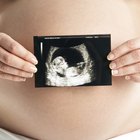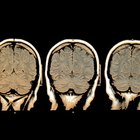How Does a Baby Get Nutrition in the Womb
From conception to birth the development of a baby follows a predictable path.
As cells divide and differentiate, the developing baby begins as a zygote, forms into a blastocyst, becomes an embryo and then transforms into a fetus, all in the first trimester of pregnancy.
From the very beginning, the developing cells need oxygen and nutrients. The fetus receives its nutrition from the mother through the placenta and the umbilical cord.
Formation of Placenta
The placenta--defined as a temporary organ consisting of blood vessels and membranes that unite mother and fetus--begins to develop as the blastocyst, a hollow ball of cells, implants in the uterus. The inner cells of the blastocyst become the embryo while the outer layer fills with blood from the mother's uterine lining. Blood vessels form in this area between the embryo and the mother's uterus until--by day 21--the mother's blood surrounds the embryo's blood vessels, allowing the exchange of nutrients, as described by Penn Medicine.
Functions of Placenta

Placental Development in Pregnancy
The placenta contains a collection of thin tissues, known as the blood barrier, that permits some particles to flow between the bloodstream of the mother and fetus while restricting others.
The placenta transfers oxygen and nutrients from the mother's blood to the placenta and transfers waste products from the placenta's blood to the mother's blood. It also produces hormones, including human chorionic gonadotropin, or hCG, estrogen and progesterone, to signal the baby's needs to the mother. Lastly, the placenta protects the fetus from harmful particles, such as the mother's red and white blood cells, which can treat the baby as a foreign invader.
Source of Nutrition
As the mother eats, the food passes through the digestive system where the body breaks it down into small particles the body can absorb. The nutrients travel through the mother's bloodstream and exchange to the bloodstream of the fetus through the placenta. In addition to ingested food, the mother's body continually breaks down muscle, fat and bones, releasing proteins, fat and calcium to the mother's blood that can be absorbed through the placenta to provide nutrients to the fetus, as described by Nutrition in the Womb.
Formation of Umbilical Cord

4 Parts of the Brain Not Protected by the Blood Brain Barrier
When the placenta forms, the embryo and placenta connect through a stalk surrounded by the primitive umbilical ring.
As the embryo grows and develops into a fetus, the stalk also grows while developing two arteries and a vein. As the gastrointestinal system develops, it protrudes through the umbilical ring, forming the longer umbilical cord. The umbilical cord provides the pathway for fetal blood to flow to and from the placenta.
Flow of Blood
The umbilical cord serves as the lifeline for the fetus.
The two arteries carry blood pumped from the left ventricle of the fetal heart to the placenta to receive oxygen and nutrients from the mother.
The vein returns the oxygenated blood from the placenta back to the right atrium of the fetal heart.
The umbilical cord usually reaches 60 to 70 centimeters by birth, according to the Yale University School of Medicine. Fortunately, a rich matrix made of proteins and carbohydrates, known as Wharton's jelly, surrounds the arteries and veins, preventing the cord from twisting and cutting off the supply of nutrients to the fetus.
How Does a Baby Get Nutrition in the Womb
Source: https://www.hellomotherhood.com/article/230923-how-does-nutrition-get-from-the-placenta-to-the-fetus/
0 Response to "How Does a Baby Get Nutrition in the Womb"
Post a Comment